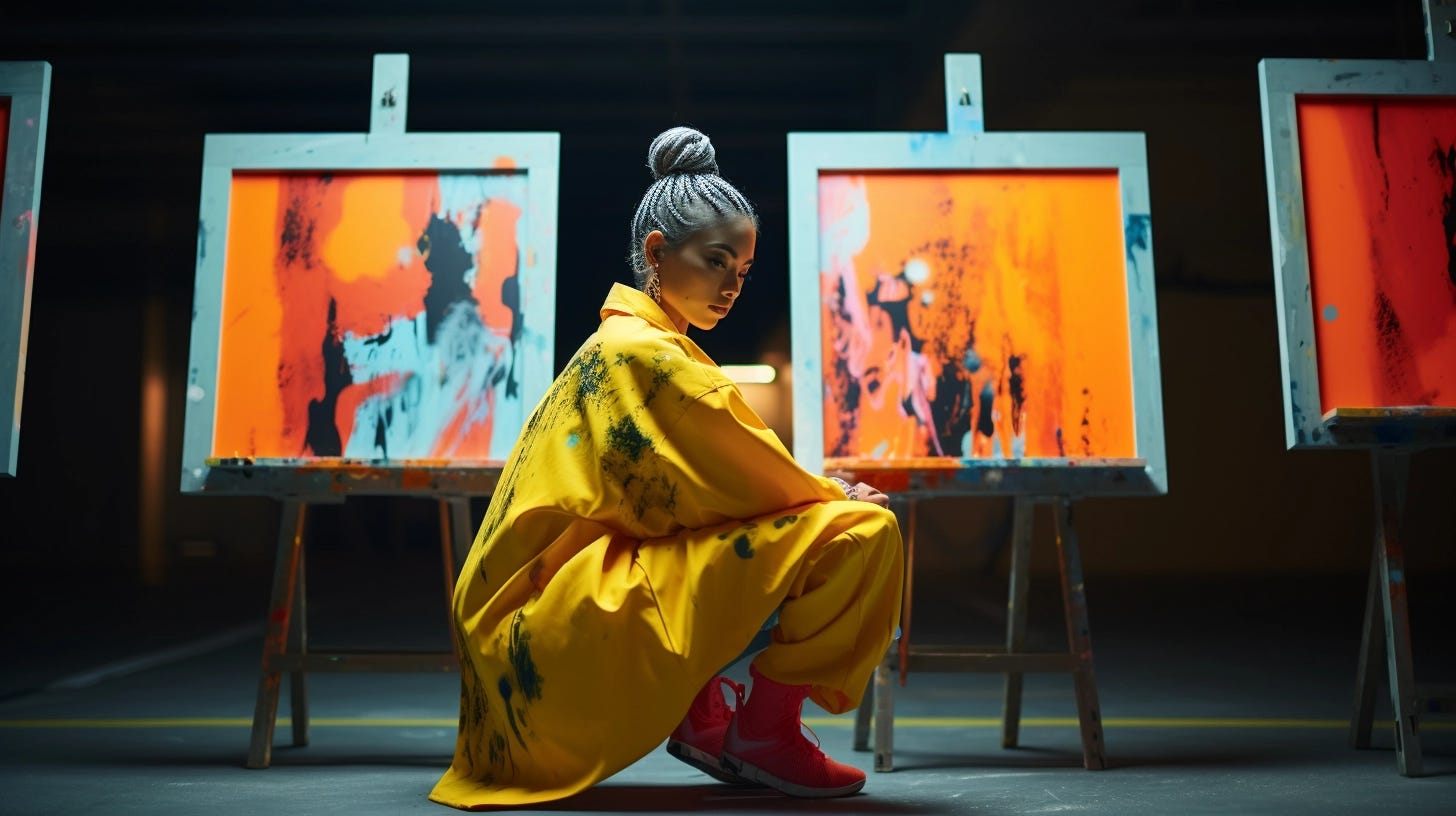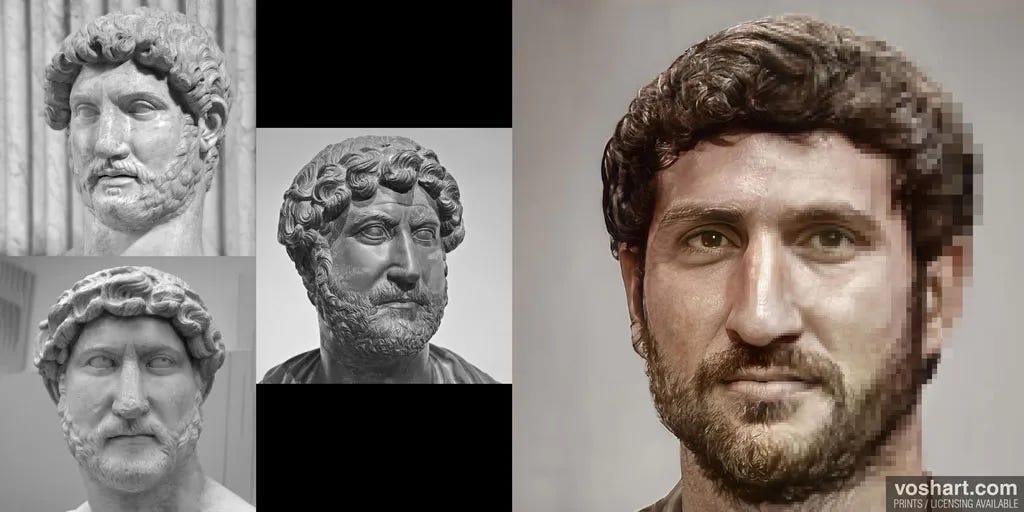Step into the world of ancient Rome, where art and technology collide!
Using a neural network called Artbreeder, the artist processed over 800 sculptures, breathing life into the frozen faces of history and facing solid critiques.
The result is a stunning collection of AI-generated portraits, each a window into the past.
But the past emperors couldn’t have looked pale and chalky like a Northern European.
As the project gained attention, a backlash ensued, with critics questioning the accuracy of his recreations.
The debate sparked a broader conversation about the responsible use of AI, the importance of accurate data inputs, and the need for transparency in the creative process.
And many others tried, like this one:
The Color of Power:
Rethinking Roman Emperor's True Hues
This podcast explores GenAI through a 2020 project by Daniel Voshart, a Canadian cinematographer and VR designer who used machine learning to create photorealistic reconstructions of 54 Roman emperors.
Using a neural network named Artbreeder, Voshart processed images from around 800 sculptures to generate realistic facial features, enhancing them further with manual adjustments in Photoshop based on additional sources like coins and historical texts.
Overview and Outline:
I. Introduction to the podcast topic and the controversy surrounding Voshart's AI-generated images of Roman emperors.
II. Voshart's approach: Using ArtBreeder and carefully curated statue images to generate initial portraits.
III. The criticism: The portraits are accused of depicting an inaccurate, "Aryanized" complexion due to flawed data sources.
IV. Voshart's response: Embracing feedback, removing problematic sources, and iteratively refining the portraits.
V. Lessons and recommendations for using AI effectively:
1. Improve data training with diverse and accurate inputs ("garbage in, garbage out")
2. Iteratively refine AI outputs through human intervention
3. Embrace feedback from the audience/critics
4. Be transparent about sources and methods
VI. Voshart's entrepreneurial success: Selling prints and image licenses on Etsy.
VII. Conclusion: AI is a collaborative tool incorporating human feedback and ingenuity.
Dunn portrays the controversy surrounding the images, with critics lambasting the "northern European complexions" depicted, accusing the portrayal of being akin to an "Aryanized" representation of history.
He describes the criticism as a "firestorm," with comments "blowing up" on social media.
The podcast also offers a glimpse into Voshart's entrepreneurial spirit, describing his Etsy store as a testament to his hard work, with over 1,100 sales of prints and image licenses ranging from $30 to $55 each.
4 Step Process for Using GenAI:
1. Provide diverse, high-quality, and accurate inputs ("no garbage in, garbage out") to improve data training.
2. Iteratively refine the AI outputs through human intervention, using tools like Photoshop to enhance and correct the results.
3. Embrace feedback from the audience and critics, and be willing to adapt and improve based on their input.
4. Be transparent about sources, methods, and any limitations or biases in the data or approach.
Quotes:
"The more people see this kind of crap, the more they actually believe." (Criticism of the potentially misleading depictions)
"Listen to your audience." (Advice on embracing feedback)
"How can you give it more real data rather than based on what it knows, which is, in this case, was often white northern European males." (On the need for diverse data inputs)
Takeaways:
· Machine Learning: Voshart employed Artbreeder, a machine learning platform, to interpret and transform existing busts into detailed, colorized portraits.
· Artistic Enhancement: After generating the initial images with AI, Voshart used Photoshop to manually adjust and refine the details based on historical descriptions and other artworks.
· Historical Accuracy: The project aimed to provide a more realistic view of what these emperors might have looked like, focusing on preserving historical integrity through careful source selection and feedback integration.
Learnings:
· Potential of AI in Historical Research: The project showcases the potential of artificial intelligence in enhancing our understanding and visualization of historical figures.
· Importance of Cross-Disciplinary Work: Combining technology with traditional historical research yields enriching insights.
· Public Engagement and Education: Such projects advance academic research and engage the public's interest in history through compelling visual media.
The Creative Alchemy of AI and Human Ingenuity
While the AI did the heavy lifting of modeling realistic facial features from sculpture data, Voshart didn't accept its output verbatim.
He refined each AI-generated portrait using Photoshop, referencing historical texts, coins, and artwork to incorporate vivid colors, hairstyles, and other unique personal details. It culminated in an iterative process that harmoniously blended cutting-edge tech with human creativity and historical scholarship.
His approach to recreating the faces of Roman emperors is a blend of creativity, tech, and data-savvy, and being open to feedback:
1. Built with AI - Machine Learning: through tools like Artbreeder, combining data from hundreds of sculptures to generate facial features. This technology allows for an iterative and evolving creative process.
2. Artistic Tunings: After AI generation, Voshart applies manual adjustments using software like Photoshop. This step allows him to use his artistic judgment to enhance realism or adjust features based on additional historical data, such as coins and paintings.
3. Historical Feedback:. Adjustments are made based on advice to ensure historical accuracy and to address controversies, such as the pale, chalky skin and blonde hair challenged for Roman emperors from Italy, Spain, and Northern Africa.
4. Public Interaction:. Feedback from this wider audience helps with revisions.
This approach brings a forgotten era to life. It opens up discussions on the ethical responsibilities of using AI in historical reconstruction.
The Truth Behind the Faces: Decoding Roman Emperor Portraits
This began as a simple reposting of a cool video in which statues of Roman Emperors have their faces revealed using AI and the talents of a Canadian Virtual Reality designer.
It has so much to teach us about creating excellent work with GenAI, including a four-step process for you to apply at the end.
But then the critics jump on – the first is a longtime friend - so maybe it's not surprising for social media. Still, this is intelligent:
“The coming wave of this kind of thing reveals a pedestrian response to what these statues represent. They are illustrations rather than art, and worst of all, they pose as knowledge using the biggest liar of all: digital photographic representation as if it is truth.
But the danger lies in the fact that the more people see this kind of crap, the more they actually believe it is truth.” Geoffrey Laurence,
Geoffrey’s critique rejects the premise of using AI to recreate historical figures in this photorealistic way.
Viewing these AI-generated portraits as disconnected from the harsh reality of ancient Roman society that we can never fully recreate or understand as modern people.
These are contemporary views of Roman visages based on limited evidence, not a reconstruction of how they definitively looked and the experiences behind those appearances.
"These were Italian/Mediterranean men, yet they all have very northern European complexion.
I've seen this in all other AI image generators. they are all biased. It may be unintended and just trained on what’s out there.” Antonio Seijas Fernandez
Both comments raise valid critiques and concerns about the AI-generated portraits of Roman emperors.
Antonio's critique is that the portraits depict the Roman leaders with northern European/pale complexions, which may be an artifact of biases in the training data rather than accurately reflecting their likely Mediterranean appearances.
This gets to the core issue of AI systems maintaining societal biases and inaccurate representations if not carefully monitored during training.
His suggestion to examine the training dataset is smart—it will likely reveal skews that led to this northern European aesthetic being imposed on Roman subjects.
Seeing unexpected pale complexions doesn't mean the fault lies with the AI - the creator may have chosen to portray the emperors that way based on his own research and creative choices. More transparency around the process is needed.
Both comments also touch on broader societal concerns about AI systems promoting dangerous stereotypes, misrepresentations, and abuse of technology if not guided.
These comments represent reasonable skepticism about any AI system's outputs being taken as objective ground truth, especially on topics of cultural representation.
As with most emerging and powerful technologies, AI's full positive potential likely lies in developing and applying human guidance and ethical guardrails—not in rejecting its use entirely out of legitimate yet generalized fears.
Ethical AI begins with Ethical Data.
In humanizing these ancient figures, Voshart provided a compelling counternarrative to attempts to depict Roman leaders as Aryan ubermenschen by racist ideologues of the past.
By grounding his work in historical research and AI data improvements, he demonstrates how this technology, guided by a strong vision and feedback, produces the best results.
The potential of AI as a collaborative partner for artists, designers, and creators is alluring. However, care still needs to be taken to respect history and truth.
AI Tools and Approach
His approach went beyond taking the AI output at face value:
1. He curates the dataset of bust images to feed into the systems, prioritizing high-quality sculptures from the emperors' lifetimes.
2. He continually refines the AI outputs using Photoshop and historical references, such as ancient texts, coins, and artworks. This allows him to incorporate realistic skin tones, hairstyles, unique facial features, etc.
3. He embraces a feedback loop that identifies limitations in the pictures (e.g., unnatural skin palettes). He tweaks the input data (e.g., feeds in example portraits with the desired skin tones) to improve the outputs.
4. His transparent process using credible historical sources and thoughtful intervention countered past attempts to portray Roman figures through a racist/Aryanist lens.
Because he integrates AI into his creative workflow, he provides the essential human touch as a partner. The iterative process of working with AI, identifying its limitations, adjusting to new inputs/instructions, and applying discernment throughout.
This allows him to produce compelling artistic/historical work that would have been nearly impossible without AI, specifically machine learning.
However, his approach went beyond simply taking the AI output at face value.
The 4 Steps to Improve Your GenAI Projects
1. Improve the data training: He curated the dataset of quality statue images to feed AI, focusing on sculptures from the emperors' lifetimes.
For example, early AI skin tone renderings looked unnaturally pale and chalky. But by feeding in a reference portrait of a swarthy Roman emperor, he guided the system toward more realistic flesh tones for ensuing facial recreations. This flexibility to identify limitations and improve is part of what makes AI an influential collaborator for artists.
2. Refine AI outputs: He used Photoshop and historical references, such as ancient texts, coins, and artworks, to incorporate realistic skin tones, hairstyles, unique facial features, etc.
He personally refined each AI-generated portrait using Photoshop. He referenced historical texts, coins, and artwork to incorporate vivid colors, hairstyles, and other unique personal details.
3. Embrace feedback: Daniel notices limits in the AI systems' renderings (e.g., unnatural skin palettes) and updates with example portraits with the desired skin tones) to improve the results.
4. Be transparent; he cites historical sources and adapts when he learns his attempts to portray Roman figures through a racist/Aryanist lens, the source he later deleted upon
Resources
AI 'resurrects' 54 Roman emperors, in stunningly lifelike images
Appearance of The Principate [Pt. III] by Daniel Voshart
96–192: The Nerva–Antonine dynasty



















